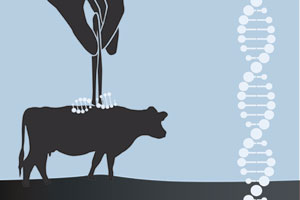Over the past decade, the dairy industry has undergone an unprecedented shift in the manner in which the underlying genetics are managed for improved productivity and health of dairy cattle. Few individuals (experts or otherwise) saw this sea change coming.

The human genome, completed in 2001, cost approximately $3 billion and required 13 years from project start to completion.
Following the completion of the human genome, experts in agricultural science argued whether the initial price tag of $50 million for a bovine genome project was worth the investment.
Advances in sequencing technology reduced time to completion, and a draft sequence of the bovine genome was published in 2009.
Completion of the bovine genome project led to the discovery of polymorphisms in the DNA sequence (locations where individual cows differ) that partially explained differences in the productivity of individual animals.
We now know that the bovine genome contains millions of these unique locations known as single nucleotide polymorphisms (SNP) or genetic markers. These genetic markers represent the millions of locations in the DNA sequence that make one cow different from another.
The SNP form the basis for modern-day genetic testing in dairy cows.
An unprecedented technological advancement – the “gene chip” – enabled the simultaneous analysis of thousands of SNP in a single sample from an individual animal at a stunningly low cost less than $150, for example, for the 77,000 (77K) marker chip.
The birth of a new era in dairy genetics was born, therefore, through a single enabling gene chip technology that brought the price of whole-genome analysis in line with the value that genomics could bring to the industry.
Dairy producers should prepare themselves for more changes in dairy genetics. The technology for inexpensive DNA sequencing is advancing at an inconceivably fast pace. Present-day sequencers have the capacity to produce 120 trillion bases in a single day.
At this level of sequencing output, a single cow can have her genome sequenced in one day for $1,000. Compare this with the original draft of the single human genome that required 13 years and $3 billion.
It is safe to assume that the speed and price of genomic sequencing will drop precipitously in the next five years. In the very near future, dairymen will obtain the complete DNA sequence of replacement animals at birth and only include those individuals that fit their herd-specific genetic criteria based on an analysis of DNA sequence.
The underlying DNA sequence of all cattle breeds are largely the same but the unique characteristics of the individual breeds presumably arises from unique DNA sequence (i.e., SNP alleles) that define one breed compared with another.
The unique characteristics of one breed include those traits that are largely viewed as superior relative to other breeds (fertility, milkfat and milk protein for Jersey or milk volume for Holstein, for example) as well as those traits that are viewed as inferior relative to other breeds (fertility in Holstein or milk volume in Jersey).
If DNA sequence defines a breed, and DNA sequence also defines desirable and undesirable traits for dairy cows, then there is an obvious question that faces the modern-day dairy industry: What is the future of individual breeds given the fact that genetic testing will identify specific alleles associated with desirable and undesirable traits regardless of breed?
If individual alleles define a superior dairy cow, then why should future dairy herds be comprised of cows within individual breeds when individual breeds may or may not possess the very best alleles for a given trait?
If, for example, there are desirable alleles for fertility that are known to exist in Jerseys but not Holsteins, then shouldn’t the alleles be moved into the Holstein? Likewise, shouldn’t milk volume alleles from Holstein be moved into Jersey?
The technological advances in genomics beg the question of whether the dairy cow of the future will be defined as Holstein or Jersey or Brown Swiss, etc., or will be a cow that possesses the best alleles from a variety of breeds, so much so that she herself cannot be identified clearly as one breed or another.
This notion is, of course, identical to the composite breeds in beef (arising from cross-breeding), with the key exception that the modern dairy cow will be a genomic composite that carries desired alleles for SNP that are known to lead to superior productivity.
Bringing all of the desired alleles into a single dairy animal is a difficult task, but simulations done by the Animal Improvement Program Laboratory (AIPL) for daughter pregnancy rate, for example, indicate that doing so would give rise to modern-day dairy cattle that possess fertility far superior to our grandfather’s cattle.
But a real challenge is getting all of the desired alleles into the same cow.
How can this be done? Cross-breeding followed by back-crossing is the traditional means of moving a small number of desired traits from one breed to another, but it is doubtful that cross-breeding will be an effective tool in the assembly of a genome containing a large number of desirable alleles.
In the past year, new tools that enable the exchange (replacement) of specific pieces of the DNA within a single cell have been developed.
The process, termed “RNA guided genome targeting,” will theoretically enable the large-scale removal of undesirable alleles and their replacement with alleles known to be superior.
The targeting is done with bovine DNA (i.e., undesirable bovine DNA is replaced with desirable bovine DNA). The newly created cell that possesses the more desirable bovine genome can be cloned to create an adult animal.
An immediate application of this new technology is the correction of recessive genetic defects or the introduction of single traits (polled, for example) into highly desirable animals.
Is the notion of one dairy breed comprised of a synthetic genome containing a select group of highly desirable SNP alleles too futuristic to discuss at this time?
Perhaps, but if you told me 10 years ago that by 2013 the bovine genome would be sequenced, and that dairymen could test 77,000 DNA markers for less than $150 per sample, I would have said you were crazy.
There is work that needs to be done. We have a poor understanding of how multiple alleles interact with one another. Likewise, epigenetic modifications of DNA that occur during fetal development can change the way a gene will function.
The complexity of the genome will need to be understood better before our ability to use genomic data to its fullest capacity is realized.
Nonetheless, the future holds great promise for rapid improvements in dairy genetics that will maintain a highly productive and sustainable dairy industry. PD
Illustration by Kristen Phillips.

-
Matt Lucy
- Professor of Animal Science
- University of Missouri
- Email Matt Lucy







